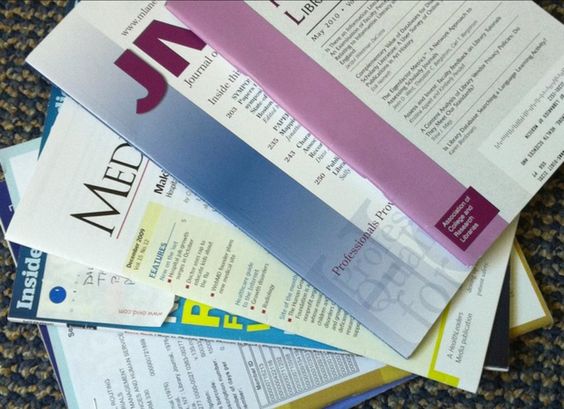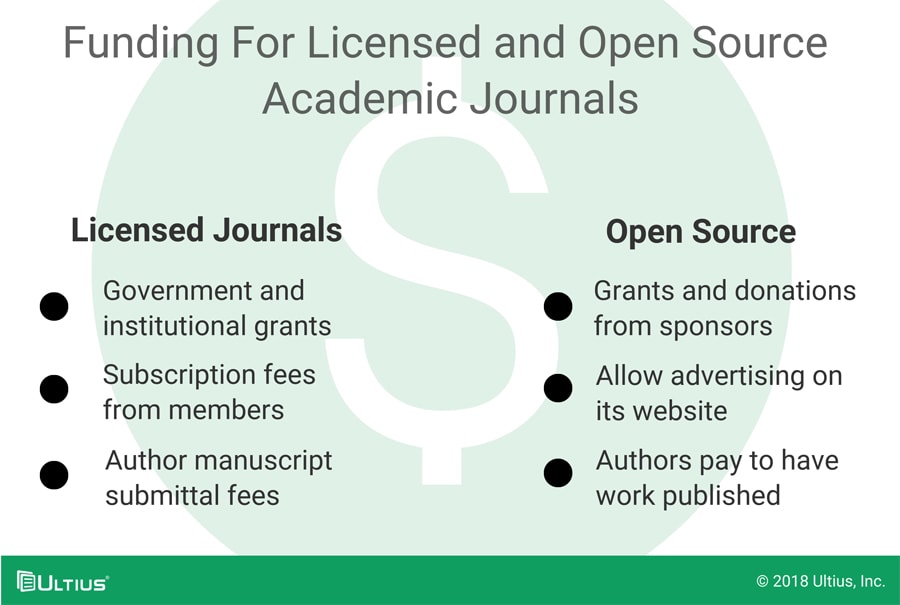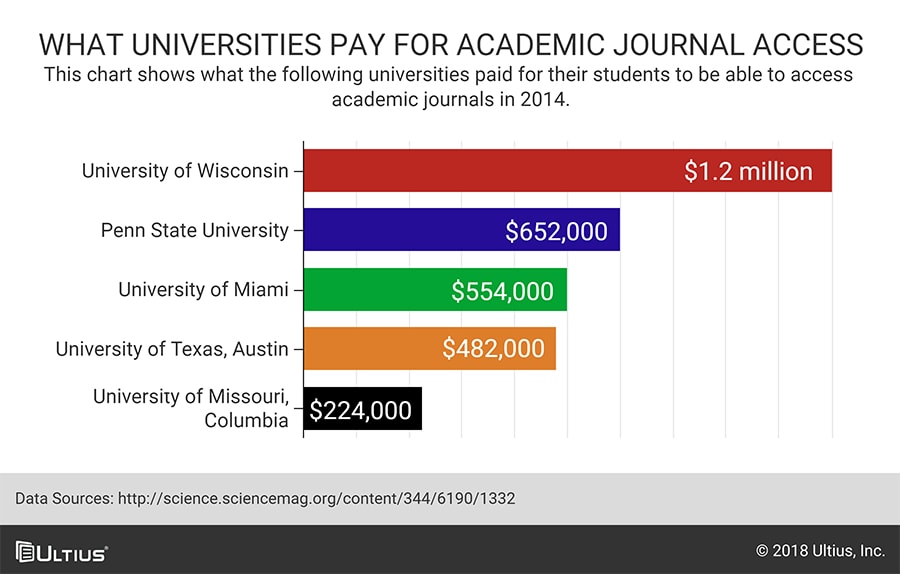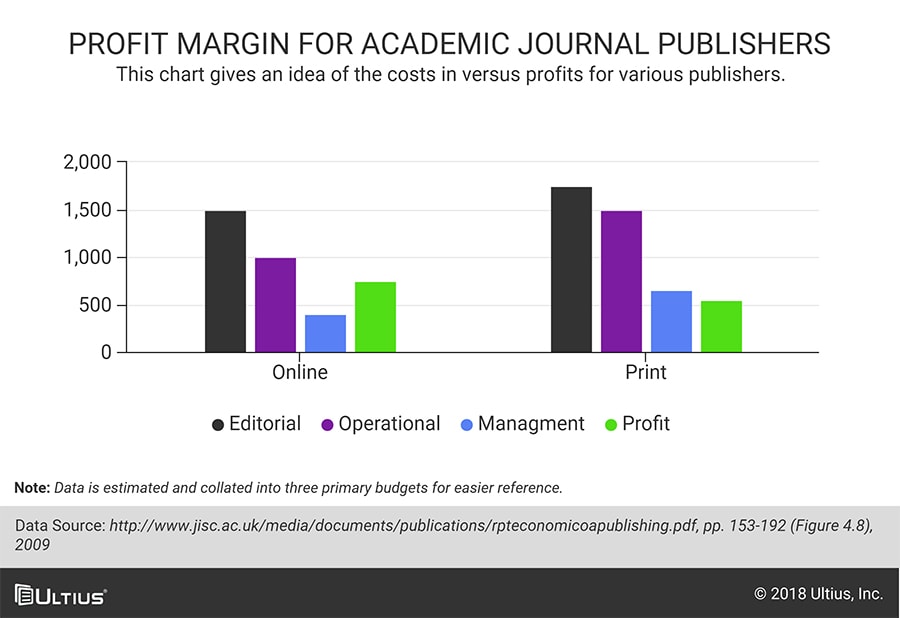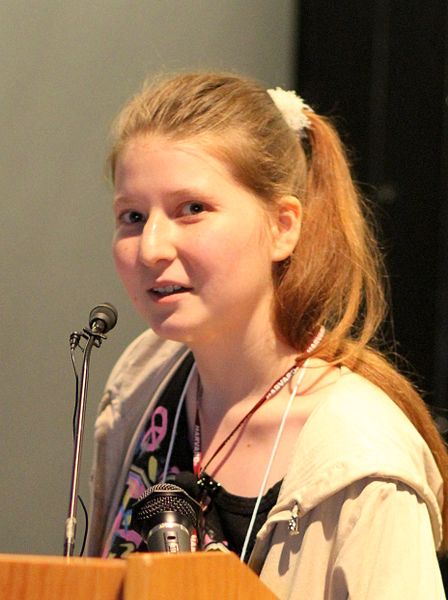Ultius Blog
The Arguments For Paid, and Open Access Academic Journals
In any prospering nation, experts and politicians have argued whether the public should have access to information, how much information, and whether that access should be free for everyone. This debate is similar to what has now happened with the academic journals industry.
Most advocates for open access believe the public owns all information created by agents of a government institution (i.e. government agencies and public schools) or created through a government grant or taxpayer money.
Business advocates and publishing houses believe free access would only hinder credible research by bankrupting legitimate publishers.
They also argue loss of jobs and reduction in editorial staff will prevent strong vetting of articles submitted to these journals.
Background and debate over free vs paid journals
Academics and researchers argue whether publishing houses should charge for their academic journals. While most researchers access articles through online databases, the rising journal costs directly impact database subscriptions.
It is understandable that these costs increase, as all services and product prices rise over the years, but federal and private grants typically bankroll these projects. Researchers and academic organizations believe the material should be free, since tax money finances the work(s).Paula Gantz wrote her report for the Professional Scholarly Publishing Bulletin that the cost increase doesn’t accurately represent the big picture, and claims libraries receive more than they spend.
using list prices of print subscriptions to calculate the real increase in serials expenditures is a misleading and inaccurate method for tracking how libraries are spending their budgets fails recognize increased value they receiving from print-to-digital transition. Libraries’ spending on periodicals has increased three-fold while their collections have tripled in size through new acquisitions and through expanded content in existing holdings” (Gantz, 2012).
On the other hand, these grants only pay for the actual research and not the costs incurred during the publishing phase of the project. Marketing, printing, listing the material online, and the peer-review process is costly to publications that need to recoup costs.
The economics of academic journals
While it is unclear whether open source or licensed materials are beneficial, or whether one is better than the other, both platforms are deeply impacted financially. It is a symbiotic financial relationship in which both sides benefit/suffer from the other.
| Revenue1 | Budget2 | Profit2 |
| $4,375-$5,625 | $3,500-$4,500 (80%) | $875-$1,125 (20%) |
| Research Grants | Updating technology | Reinvestment |
| Author Submissions | Marketing | Stocks |
| Journal Fees | Investments | Profit-Share Employees |
| Peer Review Fees | Business Operations |
| Revenue1 | Budget1 | Profit1 |
| $ 2,400 per article | $1,800 (75%) | $600 (15%) |
| Organizational Grants | Updating technology | Reinvestment |
| Donations/Sponsor | Peer Review and Editing | Expansion |
| Advertisements | Marketing | |
| Author-Pay Model | Investments | |
| Manuscript Fees | Business Operations | |
| 50/50 Model |
How academic journals are funded
Open source and licensed publications receive their funding through different channels. As a profit-earning business, licensed publications charge costly membership fees, but they also receive money through other private and public means.
The largest chunk of funding comes from government grants and subscription fees that come directly from libraries, universities, research organizations, and individual researchers.
Research grants often go directly to the research team and author, as publications rarely receive direct grants. Authors use a portion of the grants to pay manuscript submittal fees in order to get their work published.
Open source journals rely mostly on large grants from organizations such as the Bill and Melinda Gates Foundation, and the Kaiser Family Foundation. Only the most credible open source databases, that tend to focus on education of the arts and/or sciences receive funding from these sources.
The economics of paid academic journals
Licensed journals have arguably had the most significant impact when it comes to finances. During the 1960s and 1970s, larger publishing houses started purchasing the more notable academic journals. They then, increased the subscription and author-pay rates.
Database subscription fees are rising
Academic journal and database prices have increased significantly since publications were made available online. Mark J. McCabe reported in his draft report for the National Academy of Sciences, that package services increase seven percent each year.
McCabe, an economist for the University of Michigan says he cannot believe journals require researchers to pay in order to publish important information that should be publically available.
“It's still ludicrous how much it costs to publish research, let alone what we pay. The biggest travestys that the scientific community carries out peer review, a major part of scholarly publishing for free, yet subscription-journal publishers charge billions of dollars per year...for scientists to read the final product. It's a ridiculous transaction”(McCabe, Van Noorden, 2013).
| Discipline | 2015 Cost | 2015-2016 Change | 2017 Cost | 2016-2017 Change | 2017 Increase |
| Agriculture | $1,044 | $1,098 | 5% | $1,055 | 7% |
| Biology | 2,375 | $2,497 | 5% | $2,632 | 6% |
| Business/Economics | $853 | $912 | 7% | $964 | 5% |
| Chemistry | $4,311 | $4,759 | 5% | $4,506 | 4% |
| Health Sciences | $1,561 | $1,649 | 6% | $1,732 | 7% |
| Law | $550 | $583 | 6% | $612 | 6% |
| Math/Computer Science | $1,472 | $1,540 | 5% | $1,618 | 4% |
| Psychology | $918 | $981 | 7% | $1,040 | 6% |
| Sociology | $780 | $834 | 7% | $885 | 6% |
| Average | $1,245 | $1,314 | 6% | $1,385 | 5% |
The University of California at San Fransisco reports these increases are one of the reasons it cannot afford to maintain an adequate collection for its medical and health sciences students.
The UCSF Library has struggled over the last decade to maintain our journal subscriptions as well as add new resources to our collections, much to the frustration of UCSF’s prolific scholars at this world-renowned institution.
The problem is multifaceted, but two contributing factors are the pace of journal price increases and the Library’s collection budget not staying abreast of these increases" (UCSF).
Researchers compared the increase in price to other countries as well. The United States had the fifth highest priced journals among other nations in 2017, which was about $1,300 on average, and the Library Journal predicts prices will increase another six percent in 2018.
Price hikes and limiting online publishing are two of the primary causes associated with the serial crisis from 1986 to 2005.
The serial crisis
Licensed academic journals saw an average of two percent subscription increase each year until 1986. Universities complained about the price hikes because they would have to increase student tuition to cover costs, but the journals did nothing to decrease prices.
This resulted in a nearly ten percent decrease in subscriptions and eight percent increase in publishing costs during the serial crisis.
The Modern Language Association (MLA) reported that universities and libraries faced shrinking budgets during the increase in electronic sources and as the internet grew.
The top academic journal databases
Researchers, teachers, and students use academic journals to write reviews, research papers, and reinforce their own studies. This information primarily comes from peer-reviewed academic journals hosted online. They search for research using three primary tools.
Types of research tools
- Search APIs (Application Programming Interface) such as Google Scholar
- Academic databases like ProQuest, JSTOR, etc.
- Libraries and Universities
Most of these services are paid for by research companies, libraries, and universities, allowing students and researchers to use them for free or at least, inexpensively.
Stuck with writing?
Ultius can help
Paid databases
Students and academic researchers often pay to access peer-reviewed journals through an online database such as ebscoHost and ProQuest. These academic journal databases maintain an extensive collection of articles and includes content for most academic fields and disciplines. The most common databases are JSTOR, ebscoHOST, ProQuest, and LexisNexis.
Universities represent the largest spender on paid academic databases. Most pay about $300,000 each year, but some universities hit the $2 million mark.
JSTOR
JSTOR started as a non-profit initiative designed to provide students and researchers with free or reduced price scholarly articles. It primarily is a freemium database that offers academic journals, ebooks, primary sources, and research material for students and academic researchers.
As one of the smaller databases online, JSTOR prices individual access at a cheaper price than other common search companies. Users can pay $19.50 a month for unlimited access or access up to three free articles every two weeks.
ebscoHOST
Arguably one of the more popular sources for academic databases, ebscoHOST offers customized search tools for schools, libraries, and corporations. The service does not offer individual plans, and organizations often pay $10,000 to $300,000 or more for subscriptions.
The 70-year-old company was founded in 1944 and is listed as one of the largest family-owned, private corporations in America. According to the ebscoHOST website, the company holds more than 375 databases and 600,000 ebooks from 150 disciplines.
ProQuest
As with most academic databases, ProQuest primarily partners with organizations to acquire their data. ProQuest individual costs are cheaper than other services in this list, with individual usage typically about $1 per record. A one-week newspaper subscription costs $7. Being inexpensive is great, but the downside is ProQuest doesn’t offer as many publications or disciplines.
ProQuest currently owns more than 90,000 peer-reviewed sources encompassing more than three centuries, although 90 percent of its collection comes from periodicals. The service also offers a unique service to colleges and universities. It archives more than 90,000 dissertations and theses each year.
LexisNexis
LexisNexis is a specialty database focusing only on legal statutes, case law, and business filings. It also owns Martindale-Hubbell, and lawyers.com, databases and rankings for attorneys in the United States. The database primarily is accessed by legal professionals. The service charges $0 to $400 for each “clickable” online record. Many of the resources available via LexisNexis can be accessed at Cornell University for free.
The company’s revenue primarily comes from small to large law firms, colleges and universities, libraries, and government agencies. Memberships for these organizations can range from $40,000 to nearly $1 million each year.
While Elsevier does offer some free and open source material, most of its articles cost between $1,000 to $5,000 per title. The service does allow authors to pay for reader access, allowing others to use the research for free. This option is expensive for authors and regulated by the company’s double dipping policy.
Free databases
Open source databases and free resources are often easier to use than paid versions. Researchers will benefit from other experts not commonly published in major academic journals but who have a unique view of their discipline. The most common open source search engines and databases are DOAJ, JURN, and Google Scholar.
Open source and free access doesn’t always mean “free of charge”. Organizations spend money to maintain the databases, perform periodical updates, and review the material.
Free databases and search tools are operated on one or more of the following business models:
- 100% free; relies on sponsorships/donations
- 100% free; relies on advertisements
- 100% free; mixture of above
- 50/50; relies on donations and manuscript fees
- Author-pay mode
One of the most debated cost models is author-pay. Some open source journals finance their databases by charging authors a fee to submit and publish their manuscripts. This often includes peer reviews and editing, but does not include marketing or vetting, which some open access articles surely need.
JURN
JURN is another open source academic search tool that organization doesn’t actually collate items but rather it indexes open source articles from other sites using Google Search API. JURN is useful for science, arts, and the humanities, but it recently expanded its volumes to include more advanced research.
The search tool is unique because it doesn’t sell advertisements or author memberships. JURN operates solely on sponsorships and individual donations.
Google Scholar
Google Scholar is the most advanced academic search tool available online. It is powered by the online powerhouse’s search API and has more features than most paid and free alternatives. Scholar searches libraries, academic databases, websites, and books. As Google Scholar doesn’t collate material, the material’s location may charge a fee depending where Google directs the user.
This popular search engine is one of the most popular research tools. This is mainly accredited to Google’s easy-to-use API. The system is less cumbersome than ebscoHOST and LexisNexis but offers the same detailed results. Many researchers start their initial research through Google Scholar and flesh it out with more detailed information.
eMedicineHealth
Medical science is poorly underrepresented by open source databases due to the costs associated with the painstaking detail and research length of these projects. This is where eMedicineHealth comes in and offers alternatives. Each article is researched using secondary sources, and edited by medical doctors, healthcare professionals, and the same publishers behind WebMD and Medscape.
eMedicineHealth is primarily targeted towards patients, but has information beneficial to independent research projects such as vaccinations and autism, diabetes, and chronic depression. The company’s editorial guidelines are very strict and prohibits publishing any material not approved by a medical professional.
Directory of Open Access Journals
The Directory of Open Access Journals (DOAJ) is a repository of open source scholarly articles and journals. Community members submit links and potential journals/articles for the site’s moderators to review.
DOAJ relies on a 50/50% business model. Operations and database updates are funded through both private and corporate donations, and membership services. Membership services include paid subscriptions from open source databases and author manuscript submittals.
Arguments for free scholarly journals
Proponents of open source publishing believe scholarly articles should be free and accessible online. They believe in an open marketplace of ideas where each person can benefit from information and contribute their own thoughts. Free academic journals also encourages more collaboration between researchers, which results in more publications.
Open marketplace of ideas
Made popular by John Milton’s Areopagitica, the open marketplace of ideas is the theory that the Bill of Rights gives Americans freedom of expression, speech, and collaboration. Milton believed all authors have the freedom of expression and ideas should remove free of charge and accessible to all citizens.
Milton believed licensing (forcing others to purchase the material) was a form of censorship and illegal under the constitution. Milton wrote:
For books are not absolutely dead things, but do contain a potency of life in them to be as active as that soul was whose progeny they are; nay, they do preserve as in a vial the purest efficacy and extraction of that living intellect that bred them.
And what do they tell us vainly of new opinions, when this very opinion of theirs, that none must be heard but whom they like, is the worst and newest opinion of all others, and is the chief cause why sects and schisms doe so much abound and true knowledge is kept at distance from us ; besides yet a greater danger which is in it (Milton, 1644).
This philosophy is based on the foundation that knowledge is power and Americans have the right to make informed decisions. Numerous supreme court decisions have solidified the fact that open ideas are not only crucial to a solid democracy but represents a fundamental right.
The open education movement supports free access to research and academic journals. They believe it gives students the advantage to learn more from other people’s ideas and learn critical thinking skills through collaborative feedback.
In a statement to Ultius, Marcus Hanwell of Kitware Inc, (a company that develops open source software, and supports it through training, contracts, consulting services and books) says
“Journal articles should be free. They predominantly disseminate scientific research funded by governments using taxpayer money and by philanthropic organizations. It is these outputs that are the primary source of scientific debate, and the form of funding is an important aspect of the debate.
The privatization of publicly funded research not only impedes scientific progress, but it denies access to those who have bore
After leaving academia, I came to understand this plight, being denied what appears to be an open resource from within academia. Even some of my own papers are behind paywalls.” (EFL)
Jan Hylén and the Organisation for Economic Co-operation and Development in France encouraged the European Union (EU) to pass legislation requiring academic journals to make their content readily available to students and teachers. (Hylén) The United States Supreme Court (SCOTUS) ruled:
“Like the publishers of newspapers, magazines, or books, this publisher bids for the minds of men in the marketplace of ideas.” (United States v. Rumely)
Brandenburg v. Ohio added the marketplace of ideas philosophy as the dominant public policy for freedom of speech and expression.
Taxpayers pay for the research
Proponents for free academic journals also cite taxpayer dollars are used to finance research and development initiatives. The results of these projects are published in science journals. While the White House directive makes most results public, some studies still require subscriptions.
The Center for Budget and Policy Priorities (CBPP) reported nearly two percent of the national budget went towards science and medical research programs. Each year universities and research foundations receive a piece of the $135 billion research and development budget.
Taxpayers largely foot the bill for these studies, but publishing houses still charge the public and even government-owned schools and libraries to use the results. This is why President Barack Obama made open access research a part of his education initiatives and plans to improve overall research.
The Office of Science and Technology Policy (OSTP) Director John Holdren instructed federal agencies with more than $100 million research and development budgets to make results of federally funded research results available for free within one year of publication.
Scientific research supported by the Federal Government catalyzes innovative breakthroughs that drive our economy. The results of that research become the grist for new insights and are assets for progress in areas such as health, energy, the environment, agriculture, and national security.
Access to digital data sets resulting from federally funded research allows companies to focus resources and efforts on understanding and exploiting discoveries.(Holdren)
Senators Ron Wyden (D-OR) and John Cornyn (R-TX) sponsored the Fair Access to Science and Technology Research Act of 2017, designed to create free and fair use doctrine for research conducted in the science and technology fields. Both bills are currently held up in both houses as of August 2017. Wyden said in a press statement:
“Breakthroughs in technology, science, medicine and dozens of other disciplines are made every year due to the billions in research funding provided by the American people.
Making those findings available to all Americans is the best way to lead the next generation of discovery and innovation or create the next game-changing business. The FASTR act provides that access because taxpayer funded research should never be hidden behind a paywall.” (Wyden, 2013)
Stuck with writing?
Ultius can help
Helps colleges provide more information
Colleges often complain about the overwhelming cost for purchasing academic journal or database subscriptions. Even powerhouse universities like Harvard University are feeling the bite. Harvard Library issued a memo to the school’s faculty urging them to boycott academic journals because it could not afford the rising costs.
Harvard reported it spent $3.5 million each year, or ten percent of the library’s entire budget, on these subscriptions and was considering transitioning to open source alternatives.
Other colleges have significantly decreased, eliminated, or replaced their database collections including State University of New York at Potsdam, University of California at Los Angeles, and the University of Alabama.
Arguments against free scholarly journals
Opponents believe academic journals must remain independent, profitable business models to protect the integrity of research and maintain healthy economic competition. They claim these companies have a constitutional right to charge and profits actual help research and academic institutions, not hinder them.
Capitalism, and the journal's right to charge for access
The United States has a capitalist form of economic commerce. Individuals are allowed to own their company, make money, and compete in the global marketplace. Corporations have a constitutional right to charge and make profit.
While the government ensures fair commerce and prevents companies from mistreating the public, there is not much the federal or state agencies can do to prevent legal business models. Legislatures and company executives state the capitalist business model applies to academic journals and is needed to create an unbiased atmosphere.
Recouping publication costs
Charging fees to access academic journals are not always about making money. Publishers and databases incur costs and overhead which must be recaptured through access and membership fees.
Any publisher has to cover operating costs, which are primarily made of (i) article processing charges (APCs), (ii) management and investment costs, and (iii) other costs. Article processing includes editing, proofreading and typesetting, among other things. Management and investment are instead the marginal costs needed to establish and keep the journal running.
Other costs include promoting the journal, hosting and infrastructural services, sponsoring conferences, and other services that are extrinsic to research articles themselves. The average production cost for a single research article is estimated to be around $3500–$4000 but these costs are highly depending on the publisher. (Tennant, 2016)
Most scholarly journals barely recoup 20 to 30 percent of their costs. The real profits come from author-pay models and grants from private, public, and government entities. University of Cambridge mathematician Timothy Gowers said he understands how journals could hold hard feelings about pricing misconceptions.
“If you see it from the perspective of the publisher, you may feel quite hurt. You may feel that a lot of work you put in is not really appreciated by scientists. The real question is whether that work is needed, and that's much less obvious.”(Van Noorden, 2013)
Erosion of the peer review process
Peer reviews are the foundation for any scholarly journal. The vetting process protects research integrity and ensures all material is accurate before it is published. Removing this process significantly hinders academic research and creates journals no more professional or accurate than Wikipedia.
Wikipedia
Another concern with losing the peer review process is the increased use of Wikipedia for academic research. With the decrease of peer reviewed journals and dominance of open source material, students doesn’t realize the difference between non-credible and credible sources.
The University of Washington’s School Project Information Literacy recently reported 80 percent of students use/used Wikipedia during their studies and research writing in 2010. It is not unreasonable to suggest that number is still that high in today’s busy student’s life.
While professional researchers know to stay away from these information warehouses and only use them for brainstorming, professors report an increase in Wikipedia citations. Most information publishing on this site is not reviewed for accuracy and writers do not have the qualifications to create content in most of the published disciplines.
Wikipedia founder Jimmy Wales, recommends against using the site for academic or research purposes:
“I don't think people should cite it, and I don't think people should cite Britannica, either. People shouldn't be citing encyclopedias in the first place.
Wikipedia and other encyclopedias should...give good, solid background information to inform your studies for a deeper level.” (Wales, Green, 2005)
Paid journal supporters believe that investing in academic journals and providing students with more viable and vetted options will decrease the use of sites like Wikipedia.
Peer review integrity in licensed and open source journals
Investing in the peer review process is expensive and costs about $1,850 or 40 percent of the overall article publishing budget. Open source journals do invest in the peer review process, but primarily rely on voluntary review from unknown academics. Paid journals only use the top experts in the field to ensure accuracy and integrity.
Open source journals cannot afford to properly review articles for accuracy and research methodology, as is evident with a 2009 hoax article generated by a computer program. The article was jokingly submitted by two authors under the open source author-pay model. More than 50 percent of paid and open source journals using the platform published the article. The editor of the journal announced his resignation shortly after.
The fake, computer-generated manuscript was submitted to The Open Information Science Journal by Philip Davis, a graduate student in communication sciences at Cornell University in Ithaca, New York, and Kent Anderson, executive director of international business and product development at The New England Journal of Medicine.
They produced the paper using software that generates grammatically correct but nonsensical text, and submitted the manuscript under pseudonyms in late January (Gilbert, 2009).
In a similar incident, a high profile writer for Science magazine and other prestigious science publications targeted the open source industry in 2013. The journal was purposely inaccurate and focused on the subject of a lichen constituent. This error lead to apologies by the world’s most renowned academic journal databases such as Sage Publications, Elsevier, and the Journal of Natural Pharmaceuticals.
While these two incidents may seem relatively minor, researchers for the US National Library of Medicine report open source citations have increased by 40 percent and are used more than peer reviewed sources from paid journals. This means misinformation is potentially increasing and vetted research is on the decline.
Paying protects against plagiarism
Open source databases can be a breeding ground for plagiarism. The internet has given violators the chance to purposely or unknowingly copy and use another person’s research without their permission. Since some open source collections use computer algorithms to collate material and rarely check for plagiarism, researchers unwittingly become victims and hurt their reputation.
The plagiarism problem facing paid journals come in two forms – open source databases publishing plagiarized articles and open source advocates stealing material from licensed sources illegally. Alexandra Elbakyan and Aaron Swartz are just two of the most infamous violators.
| Alexandra Elbakyan | Alexandra Elbakyan is a Kazakhstan native who rose to academic fame during her 2010 college career, but she was unhappy with the high-priced academic journals. She created Sci-Hub, an illegal depository of licensed journals using stolen login credentials. Both Elsevier and The American Chemical Society (ACS) sued her and the site was shut down. |
| Aaron Swartz | Aaron Swartz was a computer programer, writer, and social activist who believed the public had a right to access free information. Creative Commons, RSS feeds, and markdown publishing where among hiw top open source contributions. Swartz was arrested for stealing JSTOR collateral and illegal publishing them for access. He committed suicide before charges were brought before the court. |
Spammers have a love-hate relationship with academic journals. After Alexandra Elbakyan’s Sci-Hub incident and Aaron Swartz used computer programs to lift material, many licensed versions blocked search engines from accessing its content via login credentials and robots.txt. This created an opportunity to post stolen material on Google.
As [far as] Google is concerned, when a spammer posts a lifted academic paper, he or she is posting an original work. This creates a real problem for researchers. The impact of a paper is largely determined by the number of times it is cited in other works.
However, when spammers pollute relevant keywords with bogus copies, it becomes more difficult to find the original work or those doing the searches might be led to believe the paper isn’t reputable because of where it appears" (Bailey, 2015).
One of the biggest offenders is essay mills. These companies often steal information from paid journals and recreate essays for pennies on the dollar. The public can purchase pre-written research papers that include someone else’s research. The best essay writing mills rank an average of 8,000 website visitors each day.
Conclusion: So, should academic journals be free?
The question of whether journals should charge for their material is difficult to fully answer. Many opponents and proponents only look at the pros and cons that impact them personally, but there is a larger picture.
Both sides can benefit from both systems.
Open source journals benefit from the high prices charged by licensed publications. Students and researchers cannot afford to pay nearly $1 million each year to use secondary research, and libraries and universities are unable to justify these expenses with the invent of open source material. Large membership fees are a catalyst for researchers and students to seek help from open source organizations.
As Adam Cole, an author, musician, and independent researcher tells us:
“ I see both sides of the issue. I am both supportive of the work being done by scholars and dependent on access to their work.
As an independent researcher no longer affiliated with a university I find it very difficult to gain access to the articles I need without spending money I do not have. I do my best with what I can get for free. Nevertheless, I am certain that the quality of my work would be enhanced with better access to the full spectrum of articles.
The move to charge people like me for access has the consequence of both weakening our capacity to work, and stratifying us from people whose lives are completely entrenched in the academic world. Academic researchers are vital to our society of learning, and yet dwelling in a somewhat protected intellectual environment, or alternately required to publish whether they want to or not, they may not be driven by the same intellectual curiosity or urgency as someone in a regular job who is writing from their passion.”
Paid journals also benefit from open source databases. With more academics using these platforms, it increases exposure and marketing benefits for many licensed articles. Audiences who cannot find their needed material through open collaboration will seek more information through links and citations.
Work Cited
Bailey, Jonathan. “Open Access: Easy Access for Plagiarists.” 20 Jan 2015. PlagiarismToday. https://www.plagiarismtoday.com/2015/01/20/open-access-easy-access-for-plagiarists/. Accessed 28 Apr 2018.
Bosch, Stephen and Kittie Henderson. “New World, Same Model | Periodicals Price Survey 2017.” Library Journal. 19 Apr 2017. https://lj.libraryjournal.com/2017/04/publishing/new-world-same-model-periodicals-price-survey-2017/#_. Accessed 29 Mar 2018.
Cole, Adam. Personal communication. 01 May. 2018.
The Faculty Advisory Council. “RE: Periodical Subscriptions” Harvard University Library. 17 Apr 2012. Memorandum. http://gantercourses.net/wp-content/uploads/2013/11/Faculty-Advisory-Council-Memorandum-on-Journal-Pricing-%C2%A7-THE-HARVARD-LIBRARY.pdf. Accessed 01 May 2018.
Gantz, Paula. “Digital Licenses Replace Print Prices as Accurate Reflection of Real Journal Costs.” Association of American Publishers. Scholarly Publishing Bulletin. Vol. 11. 3. Summer/Fall 2012. http://publishers.org/sites/default/files/uploads/PSP/summer-fall_2012.pdf. Accessed 27 Apr 2018.
Gilbert, Natasha. “Editor will quit over hoax paper Computer-generated manuscript accepted for publication in open-access journal.” 15 June 2009. Nature. https://www.nature.com/news/2009/090615/full/news.2009.571.html. Accessed 27 Apr 2018.
Green, Heather. “Wikipedia's Jimmy Wales Talks BW interview with the founder of Wikipedia.” 13 Dec. 2005. Bloomberg. https://www.bloomberg.com/news/articles/2005-12-13/wikipedias-jimmy-wales-talks. Accessed 1 May 2018.
Hanwell, Marcus.Personal communication. 03 May. 2018.
Holdren, John P.. “MEMORANDUM FOR THE HEADS OF EXECUTIVE DEPARTMENTS AND AGENCIES: SUBJECT: Increasing Access to the Results of Federally Funded Scientific Research.” 22 Feb 2013. https://obamawhitehouse.archives.gov/sites/default/files/microsites/ostp/ostp_public_access_memo_2013.pdf. Accessed 29 Mar 2018.
Houghton, John et al. “A study of open access journals using article processing charges.” A report to the Joint Information Systems Committee. Jan 2009. https://www.webarchive.org.uk/wayback/archive/20140614211536/http://www.jisc.ac.uk/media/documents/publications/rpteconomicoapublishing.pdf. Accessed 2 May 2018.
Milton, John. Areopagitica; A Speech of Mr. John Milton for the Liberty of Unlicenc'd Printing, To the Parlament of England. 1644.
Project Information Literacy. “How College Students Evaluate and Use Information in the Digital Age” University of Washington. 1 Nov 2010. http://www.projectinfolit.org/uploads/2/7/5/4/27541717/pil_fall2010_survey_fullreport1.pdf. Accessed 1 May 2018.
Van Noorden, Richard. “Open access: The true cost of science publishing Cheap open-access journals raise questions about the value publishers add for their money.” Nature. 26 Apr 2013. https://www.nature.com/news/open-access-the-true-cost-of-science-publishing-1.12676. Accessed 29 Mar 2018.
Tennant, Jonathan P. et al. “The Academic, Economic and Societal Impacts of Open Access: An Evidence-Based Review.” F1000Research 5 (2016): 632. PMC. Web. 1 May 2018.
United States v. Rumely, 345 U.S. 41 (1953).
The University of California San Francisco. “Journals Cost How Much?” Library Memo. N.d. https://www.library.ucsf.edu/open-access/journals-costs/. Accessed 1 May 2018.
Wyden, Bill. “Wyden Bill Makes Taxpayer Funded Research Available to the Public.” 14 Feb 2013. Press Release. https://www.wyden.senate.gov/news/press-releases/wyden-bill-makes-taxpayer-funded-research-available-to-the-public. Accessed 1 May 2018.
- MLA Style
- APA Style
- Chicago Style
- Turabian
Ultius, Inc. "The Arguments For Paid, and Open Access Academic Journals." Ultius | Custom Writing and Editing Services. Ultius Blog, 05 Jun. 2018. https://www.ultius.com/ultius-blog/entry/the-arguments-for-paid-and-open-access-academic-journals.html
Copied to clipboard
Click here for more help with MLA citations.
Ultius, Inc. (2018, June 05). The Arguments For Paid, and Open Access Academic Journals. Retrieved from Ultius | Custom Writing and Editing Services, https://www.ultius.com/ultius-blog/entry/the-arguments-for-paid-and-open-access-academic-journals.html
Copied to clipboard
Click here for more help with APA citations.
Ultius, Inc. "The Arguments For Paid, and Open Access Academic Journals." Ultius | Custom Writing and Editing Services. June 05, 2018 https://www.ultius.com/ultius-blog/entry/the-arguments-for-paid-and-open-access-academic-journals.html.
Copied to clipboard
Click here for more help with CMS citations.
Ultius, Inc. "The Arguments For Paid, and Open Access Academic Journals." Ultius | Custom Writing and Editing Services. June 05, 2018 https://www.ultius.com/ultius-blog/entry/the-arguments-for-paid-and-open-access-academic-journals.html.
Copied to clipboard
Click here for more help with Turabian citations.

